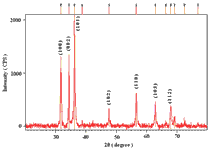Preparation, Characterization and Antibacterial Activity of ZnO Nanoparticles on Broad Spectrum of Microorganisms
Keywords:
Zinc oxide nanoparticles, minimum inhibitory concentration, minimum bactericidal concentration, X-ray diffraction analysisAbstract
Nano particles have received increased attention regarding their potential utility in biomedicine. In this study, we have investigated the antibacterial activity of ZnO nano particles with various particle sizes. ZnO nano particles were synthesized by conventional precipitation method using zinc sulphate and sodium hydroxide as precursors followed by the calcinations of precipitates at 350 °C for 6 h (sample A) and 550 °C for 2 h (sample B). The products were characterized by X-ray diffraction (XRD) analysis and morphology of the particles was evaluated by Scanning Electron Microscopy (SEM). Antibacterial activities against four different microorganisms were evaluated by determining the minimum inhibitory concentration (MIC), minimum bactericidal concentration (MBC) and zones of inhibitions using different concentrations of ZnO nanoparticles. The antibacterial activity was directly proportional to the concentration and inversely proportional to the particle size in all the microorganisms; moreover Gram positive bacteria were generally more affected than Gram negative bacteria. The stability of ZnO nanoparticles combined with potent antibacterial properties favours their application as antibacterials against broad spectrum of microorganisms.

Downloads
Published
Issue
Section
License
Except where otherwise noted, articles in this journal are published under the Creative Commons Attribution 4.0 International License
